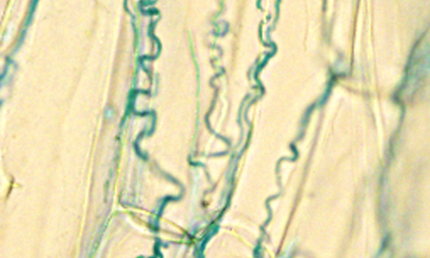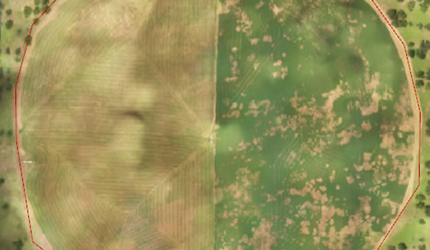5585 Guilford Road • Madison, WI 53711-5801 • 608-273-8080 • Fax 608-273-2021
www.agronomy.org
Twitter | Facebook
NEWS RELEASE
Contact: Hanna Jeske, Associate Director of Marketing and Brand Strategy, 608-268-3972, hjeske@sciencesocieties.org
Taking advantage of plants’ little fungal helpers
Sept. 7, 2016 - In the Southern Great Plains of the United States, plants have a lot to deal with. Long hot summers, strong winds, low rainfall, disease, and grazing animals challenge growth. Luckily, the plants aren’t going it alone. Many have fungal helpers, endophytes, living inside them.
 Researchers at The Samuel Roberts Noble Foundation are working to harness the power of these endophytes. The initiative, Forage365, aims to help farmers provide livestock with year-round grazing.
Researchers at The Samuel Roberts Noble Foundation are working to harness the power of these endophytes. The initiative, Forage365, aims to help farmers provide livestock with year-round grazing.
The team of scientists strategically identified four species -- alfalfa, Bermuda grass, tall fescue, and winter wheat – with overlapping growing seasons that cover the whole calendar. In addition, they have sought to identify research areas that can improve plant productivity. Their research with endophytes can help them reach this goal.
In some cases, endophytes can help the plant but still be undesirable to farmers and ranchers. In the 1930s and ‘40s, tall fescue became popular as forage. However, ranchers eventually noticed it made their animals sick. After long investigations, researchers discovered an endophyte in the grass. It produces a chemical that is toxic to the animals. But because the endophyte also helps with plant growth, scientists don’t want to get rid of it. Young explains that one solution to the problem is to find strains of the endophyte that don’t make the toxin. Different endophyte strains are similar enough to be the same species so can interact well with the grass host, but they have slightly different characteristics.
A good analogy for different endophyte strains is to think of dog breeds. It’s easy to see what environment a dog would do best in based on its different features, such as size, fur color, and fur length. For example, it’s obvious how a husky is better suited for colder areas of the world compared to a Chihuahua.
The same is true of endophytes’ specialization to the environment. While all plants have fungi living inside them, researchers at the foundation have focused on a few species to study closely to understand how they improve plant growth.
“The endophytes, found in grasses around the world, were examined. Researchers determined there were strains that were still compatible with tall fescue but didn’t cause toxicity,” explains Carolyn Young, principal investigator at The Noble Foundation. “These are the endophytes that have been used in agriculture and we now understand why they differ.”
The Noble Foundation is also working on the problem of a root rot disease, caused by a soil borne fungus. It commonly infects cotton and alfalfa in the Southern Great Plains, causing massive loses in production.
“An alfalfa field should last for at least five years, but sometimes this fungus can take out very large areas so production is significantly impacted,” Young says. “The thing to keep in mind is that this fungus has a very broad host range and infects not only cotton and alfalfa but also fruit and nut trees and many other broad leaf plants.”
thing to keep in mind is that this fungus has a very broad host range and infects not only cotton and alfalfa but also fruit and nut trees and many other broad leaf plants.”
To battle this fungus, Young and others are mapping how quickly the disease spreads across a field. They go into the field and use drones to capture aerial images so they can see what is occurring over a very large area. Young says that, so far, they know the disease can spread by nearly ten feet in a growing season. Work continues to understand and then ultimately stop its spread.
“We are funded to help improve agriculture in our region but the questions that we answer are applicable to other geographic areas and agricultural problems,” Young says. “I really like the fact that I can work across multiple disciplines, answering basic science questions and impacting the productivity of farmers.”
Young’s work was presented at the American Society of Agronomy, Crop Science Society of America, and Soil Science Society of America Annual Meeting on Nov. 16, 2015. For information about 2016's Annual Meeting, visit https://www.acsmeetings.org/.